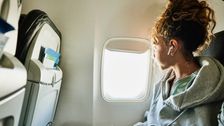
It’s hard to beat the speed and convenience of air travel. Over the course of mere hours, you can traverse thousands of miles over multiple countries.
But sitting in a metal tube in the sky for prolonged periods is not always the most comfortable experience. You have to deal with cramped seats, circulation issues, germs and other less-than-ideal factors.
And then of course, there’s the dreaded effect on your ear ― that uncomfortable and sometimes painful pressure. This phenomenon is so common it even has a name: airplane ear.
Below, doctors break down what you need to know about airplane ear, how to prevent it, and what to do if it won’t go away after you reach the ground.
What is airplane ear?
“Airplane ear is a condition that is caused by a difference in air pressure between the inner ear and the surrounding environment during air travel,” said Dr. John Whyte, chief medical officer at WebMD.
The phenomenon is also known as ear barotrauma, barotitis media or aerotitis media.
“It typically happens during takeoff or landing, causing discomfort and pain in the ears,” Whyte said. “The pressure changes can lead to the eardrum becoming stretched or, in rare cases, even ruptured. This causes pain, which can present as the ears feeling clogged or popping.”
Certain factors can exacerbate symptoms, like having sinus congestion, respiratory infection or allergies. Parts of the ear don’t function as well when you have a stuffy nose, for instance.
“Young kids have a harder time since their ear canals are much smaller,” Whyte said.
Basically, the pain or stress you feel on your ear stems comes from a lack of balance between the air pressure in your ear and in the cabin.
“When the airplane descends, the pressure in the cabin increases,” said Dr. Bradley B. Block, an otolaryngologist-head and neck surgeon and host of the “Physician’s Guide to Doctoring” podcast. “The pressure in your middle ear ― that space behind the ear drum where your ear bones are ― needs to increase as well so it is the same as the surrounding, or ambient, environment. There is a tube that connects the middle ear to the back of the nose called the eustachian tube. This is usually closed and we need to open it in order to get air into the middle ear so the pressure is the same as the airplane cabin.”
What can you do for airplane ear?
“Ways to open the eustachian tube include swallowing, yawning and blowing the nose,” Block said. “Sometimes lozenges or gum are recommended because they cause more salivation, which leads to more swallowing.”
If yawning, swallowing, blowing your nose or chewing gum don’t help equalize the pressure in your ears and relieve symptoms, there are other things you can try.
“The Valsalva maneuver, where one pinches the nose and gently blows while keeping the mouth closed, can also work,” Whyte said. “Over-the-counter decongestants or nasal sprays may assist in relieving congestion, which can change the pressure difference.”
How can you prevent airplane ear?
“Preventing airplane ear involves taking precautions before and during flights,” Whyte noted. “Avoiding excessive alcohol consumption, drinking plenty of water and refraining from sleeping during takeoff and landing.”
If you have a stuffy nose, improving nasal function is key to improving ear function.
“This is done by taking a decongestant,” Block said. “Pseudoephedrine can be taken orally, but has some side effects that need to be considered. Topical decongestants can be effective with fewer side effects, like oxymetazoline and phenylephrine.”
He recommended ensuring you take the proper dose to ensure the medications don’t wear off before the plane lands.
“Another way to prevent ‘airplane ear’ is by wearing special ear plugs during descent,” Block added. “These ear plugs have a ceramic filter in them, and because ceramic is porous, it allows a little air to flow through, so the ears have more time to equalize the pressure.”
Basically, earplugs help by slowing down the change in pressure and giving your ears more time to adjust to the shift.
“Swallowing, yawning and gently blowing the nose when the ears start to feel clogged can help the middle ear to remain at the same pressure as the airplane cabin as the plane is descending,” Block said. “If the eustachian tube won’t open as the cabin pressure is increasing during descent, the middle ear pressure starts to drop. The ear drum starts to get sucked in and the stretch of the drum causes pain. The middle ear can fill with fluid, so there is temporary hearing loss.”
He explained that there is “a point of no return” after which the pressure in the middle ear is too low, so there’s a vacuum effect and the eustachian tube won’t open.
“Eventually, the eustachian tube will open and the fluid will resolve, but this can take hours to days and sometimes weeks,” Block added. “Unfortunately, there are no medications that can help expedite recovery, but gently blowing the nose can help the eustachian tube start to open faster.”
If the pain continues long after the plane has landed or you have trouble hearing, seek medical attention to determine the best course of action.
Source link
CHECK OUT: Top Travel Destinations
READ MORE: Travel News



